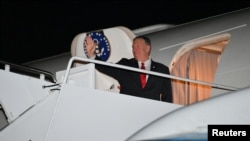U.S. Secretary of State Mike Pompeo and Defense Secretary Mark Esper departed for India Sunday to strengthen bilateral security cooperation as Washington looks to confront Chinese geopolitical and economic challenges in the Indo-Pacific region.
Besides New Delhi, the top U.S. diplomat is also traveling to Sri Lanka, Maldives, and Indonesia from October 25-30.
In India, Pompeo and Esper joins their counterparts for the third annual U.S.-India 2+2 Ministerial Dialogue.
“The 2+2 discussions will focus on global cooperation, on pandemic response, and challenges in the Indo-Pacific: economic space and energy collaboration, people-to-people ties, and defense and security cooperation,” said Dean Thompson, deputy assistant secretary of the State Department’s Bureau of South and Central Asian Affairs.
The two nations are also set to lay the groundwork for the signing of the Basic Exchange and Cooperation Agreement for Geospatial Cooperation or BECA, which is seen as the final strategic agreement leading to closer security ties.
BECA “can be viewed as the last piece for the puzzle of mutual strategic cooperation that New Delhi and Washington have worked on together for the past five years,” said Roger Liu, an associate professor of political science at FLAME University in Pune, India.
The talks between top U.S. and Indian officials come at a time of increased tensions between India and China. In addition to widespread anger related to the coronavirus, which originated in China, there are also increasing concerns about China’s more aggressive approach in the Himalayan border dispute. Recent clashes have killed at least 20 Indian soldiers along with an undisclosed number of Chinese.
For the first time, a U.S. maritime patrol aircraft refueled at India’s Andaman and Nicobar islands recently, showcasing the military cooperation between the two countries amid India’s standoff with China along the border in eastern Ladakh.
“After BECA is signed in the third US-India 2+2 meeting at the end of October, the Indian armed forces will have access to the U.S. satellite image and sensory data — the signal intelligence, or SIGINT — during the time of conflict," said Liu on Wednesday. "The interoperability between the U.S. and Indian armed forces thus is further enhanced."
India has maintained a non-alignment stance for years. But senior U.S. officials have seen “a steady progression of cooperation” that reached “a new level in recent months and years.”
U.S. Deputy Secretary of State Steve Biegun told reporters in a recent phone briefing that U.S.-India relations have “never been better” since the early 1990s, when the two counties “really began opening up to each other.”
Esper also said meetings with senior Indian officials would reflect the need for "a lot more close collaboration" on challenges in the Indo-Pacific region, where China is building its presence.
“Together these efforts will strengthen what may become one of the most consequential partnerships of the 21st century,” said Esper in his remarks to the Atlantic Council, a Washington-based think tank.
Washington and New Delhi are also expanding their defense trade cooperation. India is increasing its defense equipment purchases from the U.S., from nearly zero in 2008 to a sharp growth of over $20 billion by the end of 2020.
In 2018, India was allowed to receive license-free access to a wide range of military and dual-use technologies regulated by the U.S. Department of Commerce.
During his South Asia trip next week, Pompeo travels to Sri Lanka, where he says he will underscore the U.S. commitment to a “strong” and “sovereign” Sri Lanka, a tiny island country that has seen an influx of Chinese investment in the last decade.
China has invested billions of dollars in Sri Lanka in a string of infrastructure projects, from oil refineries and highways to a strategic port that it now operates. Beijing sees the country, which lies close to key shipping lanes, as a key link in its Belt and Road initiative.
Pompeo’s travel to Malé comes after the U.S. and Maldives signed a defense agreement on September 10 to “deepen engagement and cooperation” in the peace and security in the Indo-Pacific region.
Regional maritime security and the fight against terrorism are high on the agenda, according to the State Department.
After Malé, Pompeo heads to Jakarta, Indonesia, where he will underscore religious freedom and human rights in the world’s most populous Muslim majority nation, according to U.S. officials.
The top U.S. diplomat is scheduled to attend the Anshor Youth Movement Forum, which is the youth wing of Nadhatul Ulama, the largest Muslim organization in Indonesia.
During an October 21 press briefing at the State Department, Pompeo said he will discuss “commercial issues, security issues, and diplomatic issues” and affirm the two countries’ vision of a free and open Indo-Pacific in meetings with Indonesian President Joko Widodo and other officials.
The secretary of state told reporters that it is in the best interest of Southeast Asian nations to protect “their maritime rights” and the ability to conduct business, ensuring “that their sovereignty is protected against” threats from the Chinese Communist Party.
Beijing has built strong economic and diplomatic ties with Jakarta. China was the second largest source of foreign direct investment in the first half of this year.
Southeast Asia is the region most impacted by China’s territorial claims and militarization of disputed land features in the South China Sea, one of world's most strategically important waterways for trade and commerce.
Six Asian governments — Brunei, Indonesia, Malaysia, Philippines, Taiwan and Vietnam — have territorial claims or maritime boundaries in the South China Sea that overlap with China’s.
While Indonesia is not seen as a party to the South China Sea disputes, it has on multiple occasions detected Chinese fishing or coast guard ships in Indonesia’s exclusive economic zone off the Natuna Islands in the South China Sea.





